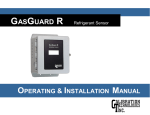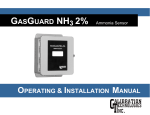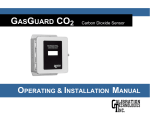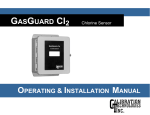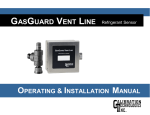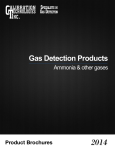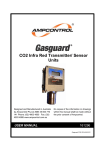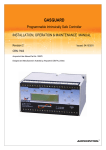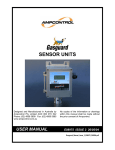Download CTI GG-NH3 User Manual
Transcript
GASGUARD NH3 Ammonia Sensor OPERATING & INSTALLATION MANUAL GasGuard NH3 Operating and Installation Manual 2 GasGuard NH3 Operating and Instruction Manual Table of Contents General description ………………………………. 4 Installation………………………………….………. 4 Locating the sensor …………………………. 4 Installation guidelines………………………… 5 Wiring………………………………………….. 6 Operation ………………………………………….. 7 Start-up ……………………………...………… 7 Calibration ……………………………….….… 7 Maintenance…………………………….………… 9 Specifications…………………………………….. 10 Warranty………………………………………….. 11 Calibration Technologies 866-394-5861 3 GasGuard NH3 Operating and Installation Manual General Description The GasGuard NH3 sensor is a +24 VDC, three-wire, 4/20 mA sensor for ammonia which utilizes proven electro-chemical sensor technology for fast and accurate leak detection. The standard detection range of the GasGuard NH3 provides real-time continuous monitoring of ammonia concentrations accurately down to 5 ppm without false alarms. We typically recommend a 0/100 ppm range for all personnel and product protection areas. Higher ranges (0/250, 0/500, 0/1000) are optional for higher alarm setpoint areas such as Engine Rooms. The GasGuard NH3 provides an industry standard linear 4/20 mA output signal compatible with most gas detection systems and PLCs. The output signal is not affected by drastic temperature and moisture variations that occur during washdown, defrost cycles, etc. The transmitter circuit board is sealed in potting compound, protecting sensitive electronic components and copper tracing from corrosion. The specially vented chemical-resistant polycarbonate enclosure protects the sensor from accidental damage, weather and direct hose-hits from clean-up crews. 4 Installation Locating the sensor One of the most important considerations when installing GasGuard NH3 sensors is that they must be easily accessible for calibration and maintenance. For optimum personnel protection (representative concentration reading that an employee would be exposed to), mount the sensor at a height in the breathing zone of the employees. It would typically be about five feet off the ground, which also allows easy access. As a general rule of thumb, try to mount sensors within 30 feet of potential leak sources. Caution: Remove protective cap. The sensor is shipped with a cap installed over the electrochemical cell to preserve cell life. The cell will not detect ammonia vapors with this cap installed. Remove cap and discard during installation. GasGuard NH3 Operating and Instruction Manual Installation Guidelines: • Remove and discard protective cell cap • Always mount the sensor vertically. • Must be easily accessible for calibration and maintenance. • Mount the sensor close to the potential leak source. • For optimum personnel protection, mount sensor in the “breathing zone” (4’ – 5’ above floor). • Take air movement and ventilation patterns into account. • To prevent electrical interference, keep sensor and • • • • • wire runs away from mercury vapor lights, variable speed drives, and radio repeaters. Protect sensor from physical damage(forklifts, etc.). If mounting sensor outdoors, consider prevailing wind direction and proximity to the most likely source of leaks. Protect the sensor from sun and rain as much as possible. Never mount the sensor in CA (controlled atmosphere) rooms because normal atmospheric levels of oxygen are required for operation. For highly critical locations more than one sensor should be installed in each room. Mount sensor enclosure through the mounting holes as shown in Figure 1. Figure 1: Mounting dimensions 5 GasGuard NH3 Operating and Installation Manual Wiring Electrical wiring must comply with all applicable codes. Electrical Power: 24 VDC regulated, 350 mA. Output: Linear 4/20 mA output. Monitoring equipment may have a maximum input impedance of 700 ohms. Cable Recommendation: 20/3 shielded cable (General Cable C2525A or equivalent). Length of cable to sensor should be no greater than 1,500 feet. Monitoring: Monitoring equipment must be configured to indicate a fault if the signal is below 1 mA. All signals over 20 mA must be considered high gas concentrations. Alarm setpoints should not be lower than 10% of full-scale range. Wiring Guidelines: • Always use three conductor, insulated, stranded, shielded copper cable. • Do not pull sensor wiring with AC power cables. This can cause electrical interference. • If cable runs cannot be made without a splice, all splice connections should be soldered. • Ground the shield at the main control panel. Connect the shield wire in the sensor terminal block labeled SHLD. Figure 2: Wiring diagram 6 GasGuard NH3 Operating and Instruction Manual Operation Start-up Sensor can be response tested and/or span calibrated immediately after power up. Allow 60 seconds for power up time delay of sensor to end (green power LED will flash during power up). Start-Up Test: 1) One person exposes each sensor to calibration gas 2) The second person stays at the control unit to determine that each sensor, when exposed to the gas, is connected to the proper input and responds, causing appropriate alarm functions. LED functions The green power LED blinks for 60 seconds during power-up, as the signal output is held at 4 mA. The LED is then continuously lit during normal operation. The red filter LED indicates EMI/RFI by blinking once per second. Extreme temperature changes are indicated by the LED being lit continuously. During normal conditions, the red LED is off. Calibration The GasGuard NH3 Sensor comes factory calibrated and should require only minimal adjustments after installation. There are two pots on the preamp that are used for calibration (see Figure 3). Note: Never measure sensor output in mA. Always use mVDC or VDC voltmeter settings. Zero Calibration: After the sensor is installed and has been powered up for a minimum of 8 hours, the unit can be zero calibrated by the following: • Be sure the unit is in clean air. • Adjust the zero pot until the sensor outputs 40 mV from Test [-] to Test [+] (see Figure 3). Note: To zero the sensor immediately after power up or cell replacement, unplug cell from the transmitter and adjust signal to 40 mV. Span Calibration: DO NOT ADJUST THE SPAN POT WITHOUT CERTIFIED CALIBRATION GAS! If span adjustment is required, use the following procedure: • Apply span gas at 0.8 L/min (span gas must be in air, not nitrogen or other carrier). • Sensor should react to gas within 15 seconds. • Once the output signal has peaked (or two minutes maximum) adjust the span pot until the correct output is achieved (see Figure 3). With full-scale span gas, the calculated span value is 200 mVdc. ((span gas / sensor range * 16 + 4) (mA output)) Note: Below are a few response characteristics which may be an indication that the gas sensor is at or near the end of its useful life. If any of these are observed, the cell should be replaced: • Slow response to / recovery from calibration gas. • Failure of the output to reach 50% of the calibration gas value prior to span adjustment. • Unable to achieve correct output during span. 7 GasGuard NH3 Operating and Installation Manual Figure 3: Sensor board components and zero/span adjustments 8 GasGuard NH3 Operating and Instruction Manual Maintenance The GasGuard NH3 was designed for long life and minimal maintenance. For proper operation it is essential that the test and calibration schedule be adhered to. Calibration Technologies recommends the following maintenance schedule Maintenance Guidelines: • The sensor is shipped with a factory calibration. • • • • Sensor should be calibrated 6 months from purchase date. Calibrate the detector at least once every 6 months. Calibration should be performed with certified calibration gas. Calibration kits and replacement cylinders are available from Calibration Technologies. In highly critical areas, a response test should be performed between calibrations to verify proper sensor response and alarm functions. This can be done with calibration gas or ammonia/water solution. The response test is not required if multiple electrochemical sensors are installed in the same room. All tests and calibrations must be logged. Sensor Life: These electrochemical cells are extremely reliable, but several things can cause the cell chemicals to become depleted including: • a period of time • exposure to high temperatures • continuous, long term exposure to ammonia When the cell becomes depleted, the unit will give no indication of failure other than that the sensor will not respond. For this reason it is absolutely essential that these sensors be calibrated on a regular basis. Typical sensor life in a refrigerated area will be two to three years. Typical life in a non-refrigerated area will be one to two years. When the cell becomes depleted, a replacement cell can be obtained from Calibration Technologies. Simply unplug the cell’s ribbon cable from the transmitter, pull the old cell from the spring clip, discard the old cell and replace it with a new one. The sensor can be calibrated after a 12 hour warm-up period. 9 GasGuard NH3 Operating and Installation Manual Specifications Detection Principle: Electrochemical Detection Method: Diffusion Gases: Ammonia (NH3) Ranges: 0/100 ppm (standard) 0/250 ppm 0/300 ppm 0/500 ppm 0/1000 ppm Custom ranges available. Call for more information Output Signal: Linear 4/20 mA (max input impedance: 700 Ohms) Power Supply: +24 VDC, 350 mA Response Time: T50 = less than 30 seconds T90 = less than 60 seconds Accuracy: +/- 5% of value, but dependent on calibration gas accuracy and time since last calibration Zero Drift: Less than 0.1% of full-scale per month, noncumulative Span Drift: Application dependent, but generally less than 3% per month Linearity: +/- 0.5% of full-scale Repeatability: +/- 1% of full-scale 10 Green LED: Blinks for 60 seconds during power-up. Stays on steady to indicate power. Red LED: Filter mode activated if blinking or on solid. EMI/RFI and extreme temperature changes trigger the filter function. Wiring Connections: 3 conductor, shielded, stranded, 20 AWG cable (General Cable C2525A or equivalent) up to 1500 ft. Enclosure: Injection-molded NEMA 4X polycarbonate sensor housing. Captive screw in hinged lid. For nonclassified areas. Temperature Range: -50°F to +140°F (-46°C to +60°C) Humidity Range: 5% to 100% condensing Dimensions: 7.7” high x 6.7” wide x 3.8” deep Weight: 2.0 lbs Limited Warranty & Limitation of Liability Calibration Technologies, Inc. (CTI) warrants this product to be free from defects in material and workmanship under normal use and service for a period of one year (gas sensor covered for six months), beginning on the date of shipment to the buyer. This warranty extends only to the sale of new and unused products to the original buyer. CTI’s warranty obligation is limited, at CTI’s option, to refund of the purchase price, repair, or replacement of a defective product that is returned to a CTI authorized service center within the warranty period. In no event shall CTI’s liability hereunder exceed the purchase price actually paid by the buyer for the Product. This warranty does not include: a) routine replacement of parts due to the normal wear and tear of the product arising from use; b) any product which in CTI’s opinion, has been misused, altered, neglected or damaged by accident or abnormal conditions of operation, handling or use; c) any damage or defects attributable to repair of the product by any person other than an authorized dealer or contractor, or the installation of unapproved parts on the product The obligations set forth in this warranty are conditional on: a) proper storage, installation, calibration, use, maintenance and compliance with the product manual instructions and any other applicable recommendations of CTI; b) the buyer promptly notifying CTI of any defect and, if required, promptly making the product available for correction. No goods shall be returned to CTI until receipt by the buyer of shipping instructions from CTI; and c) the right of CTI to require that the buyer provide proof of purchase such as the original invoice, bill of sale or packing slip to establish that the product is within the warranty period. THE BUYER AGREES THAT THIS WARRANTY IS THE BUYER’S SOLE AND EXCLUSIVE REMEDY AND IS IN LIEU OF ALL OTHER WARRANTIES, EXPRESS OR IMPLIED, INCLUDING BUT NOT LIMITED TO ANY IMPLIED WARRANTY OF MERCHANTABILITY OR FITNESS FOR A PARTICULAR PURPOSE. CTI SHALL NOT BE LIABLE FOR ANY SPECIAL, INDIRECT, INCIDENTAL OR CONSEQUENTIAL DAMAGES OR LOSSES, INCLUDING LOSS OF DATA, WHETHER ARISING FROM BREACH OF WARRANTY OR BASED ON CONTRACT, TORT OR RELIANCE OR ANY OTHER THEORY. 11 GG-NH3 02/2013












